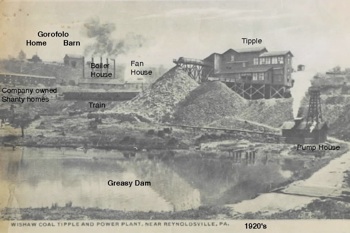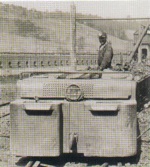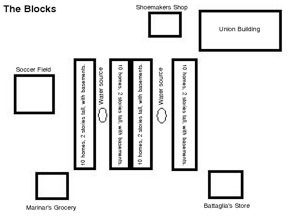The Mine was 1 of 2 biggest soft coal mines in Pa, it closed permanently in 1926.
The Mine operated 24 hours per day, with 3 shifts, year round, 5 entrances were used. Typically mining was a seasonal job with little work during the summers, due to low demand. However, Wishaw had a contract with the Johnsonburg Paper Mill, which kept our mines operating at full production 365 days per year.
The Greasy Dam was a pond located in front of the Tipple. Though it did have run off from the mines, the name was given as a derogatory label to the Italian miners. After the close of the mines, the Greasy Dam was a “quick-sand” mixture topped by about 6 inches of water. During the 30’s a boy by the name of Nistret drown in the dam. The Dam was drained in the 1980’s once drag mining began by the property owner, Erma Shaffer.
During the mine's operation, only one miner's strike took place. The strike lasted about six months and occurred around 1915-1916. The reason for this is that the miner's "had a good union," and the R&P Coal Company was "a good company to work for." -F.Nocerini
The Boiler House was 150 ft long and produced steam for operating items like miners tools.
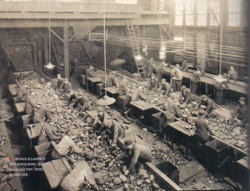
The Engine Room produced electricity for the mines, and contained the large coal scales.
The Pump House provided water to the rest of town.
Over the course of the mine's operation two men died in cave-ins. One of the men was a Scotsman who lived in the Mine Foreman's home at the current location of the Veitz/Tomasura home.
Harry Day was a popular foreman at the mines. Reportedly he was the only man not prejudiced against the Italian miners, and treated all miners fairly.
Prior to the closing of the mines, the average miner earned $7.50 per day.
August Baldauff bought the mines and Tipple following the closing in 1926.
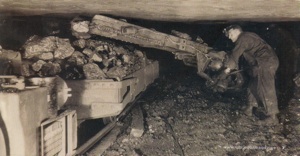
1926 the Rail Road tracks were taken out. The tracks had run in many places, among them include the valley behind Manco and Foradori/Srock homes which is now a stream, and crossed the trolley tracks at about the driveway of Phil Mennitti Sr., where they ran past the mines to the Tipple. Other tracks include the flat portions of land on the hill sides of the main curve, and leading toward Sandy Noto’s garage.
The main mine entrance can be seen in the wooded hillside at the rear of Phil Mennitti Sr.’s yard, also still there is the ramp leading from the mine to the former location of the rail road tracks, where the coal was dumped into the rail cars.
A second set of mines were located over the North East hill near Monica Bobal's home. These were called the “#2 Mines.”
"The Blocks."
"The Blocks" were company owned 2 story housing for Italian immigrant miners, mostly Sicilians. Located in the field behind the Gorofalo farm, currently the land is a horse field owned by the Torrell’s. Italian was spoken within. One non-Italian family resided here; Zukaskis.
The blocks consisted of 4 rows of homes, which were split into pairs facing each other. A street separated each row and had a communal water source at the center of both streets.
A Shoemakers shop, a Union building, Marinar’s Grocery store, and Battaglia’s store were located among the Blocks. There was also a soccer field adjacent to the Blocks.
The union building held pie socials. This is where young men would meet girls by bidding on their pies. Often fights would break out; due to a young man's friends bidding up the pies.
A “suspicious” fire destroyed the Blocks October 17, 1924. The economy was poor and leading to the depression, most work was completed in the mines at the time. The cause of the fire was never determined. Every home had a 52 gallon barrel of wine in the basement.
Frank Vizza was paid by his grandfather, Gorofalo, to remove all of the basements and debris during the summer this land was purchased following the fire. This was just prior to the depression and all the local boys helping were paid in bushels of potato’s each day.
At the base of the hill, near the train tracks of the mine, were a row of low income shanty homes.
For additional mining information contact Ray Washlaski, Editor,
“The Old Miner.”





